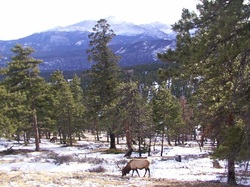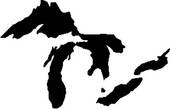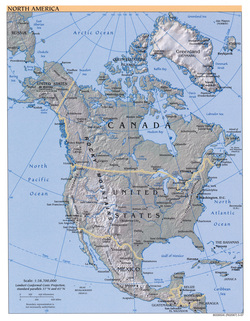
Let's Explore North America...
The region of North America consists of two countries the United States and Canada. Together we will travel and explore the fascinating sites and sceneries that we can find there. We will also learn some facts and information about each of these features to give us a bit of knowledge we might not already know.
The region of North America consists of two countries the United States and Canada. Together we will travel and explore the fascinating sites and sceneries that we can find there. We will also learn some facts and information about each of these features to give us a bit of knowledge we might not already know.
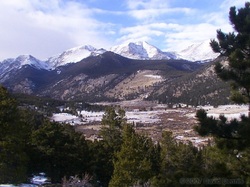
The first feature we will look at is the
Rocky Mountains
The Rocky Mountains were formed 200 million years ago as part of the break up of the super continent Pangaea. The mountains stretch from British Columbia and they end in New Mexico. They are said to be more than 3,000 miles long. The states and provinces that they encumber are British Columbia, Alberta, Idaho, Montana, Wyoming, Utah, Colorado and New Mexico. The highest peak found in the Rocky Mountains is in Mount Elbert, Colorado. This point is at 14,440 feet above sea level.
Rocky Mountains
The Rocky Mountains were formed 200 million years ago as part of the break up of the super continent Pangaea. The mountains stretch from British Columbia and they end in New Mexico. They are said to be more than 3,000 miles long. The states and provinces that they encumber are British Columbia, Alberta, Idaho, Montana, Wyoming, Utah, Colorado and New Mexico. The highest peak found in the Rocky Mountains is in Mount Elbert, Colorado. This point is at 14,440 feet above sea level.
Some of the fun things you might like to try while enjoying the Rockies are:
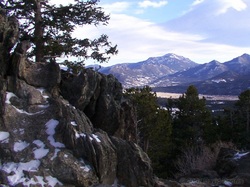
Hiking & Mountaineering
Hunting, Fishing and Camping
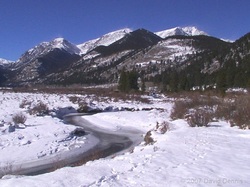
Skiing and Snowboarding
So let's move on now to our next stop the Hubbard Glacier..........
Glaciers are large masses of ice that move very slow in water and on land. They are usually found in regions where there is a great amount of snow fall with real cold winters and cool summers. The largest tidewater glacier in North America is the Hubbard Glacier.
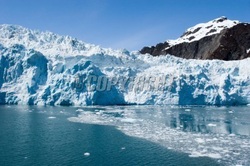
The Hubbard Glacier is located in
Yakutat City and Borough,
Alaska. The Hubbard
stretches 76 miles, of that 76 miles, 6 miles of it is open face. Most
of the ice on a glacier is under water and very old. Some can be up to
400 years old and be 2 miles thick.
Glaciers go back as far as 2 million years ago and the Great Lakes are believed to be impressions left from glaciers.
Glaciers go back as far as 2 million years ago and the Great Lakes are believed to be impressions left from glaciers.
Now to go some place warm. Let's go check out another wonderful feature of North America...the deserts!
North America has four major deserts. Of these deserts we will take a look at the Great Basin.
The Great Basin Desert in which we refer to as the "cold
desert"covers approximately 190,000 square miles. It is bordered by the
Sierra Nevada Range on the west side, on the east side it is bordered by
the Rocky Mountains that we previously discovered and the Columbia
Plateau borders the North and the Mojave and Sonoran deserts border the
South.
This desert is known for its high elevations. It is the highest elevated desert which is why it is
cold, and is made up large barren areas with juniper and pinyon trees.
I believe our next feature is something wet. Oooohhh yes, the Great Lakes.
The Great Lakes cover more than 94,000 miles and hold approximately 6 quadrillion gallons of water which is one of the largest amount of fresh surface water on the whole planet.
There are 5 , or as we find out, 4 lakes that make up the Great Lakes. These lakes are......

Lake Superior is the largest of the 5 lakes. It is in part of Minnesota, Wisconsin and Canada. This lake is 31,000 square miles. On the Minnesota side there is a lift bridge, as shown in the picture, that is in Canal Park which the boats and big ships come through to the harbor.
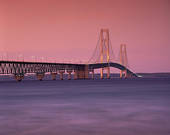
Lake Michigan and Lake Huron have two individual names and are seen as two separate lakes when they really consist of one body of water. When combined together they are the largest lake at 45,000 square miles. The states that these lakes are adjacent to are Wisconsin, Michigan, Illinois, Indiana and the country of Canada. The bridge shown in this picture is the Mackinac Bridge which connects the northern and southern peninsulas of Michigan and is the 3rd largest suspension bridge in the world.
d
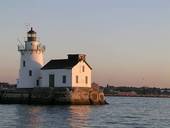
Lake Erie is the smallest and shallowest of all the Great Lakes. It also is the least populated. This lake is only 10,000 square miles. Lake Erie is in parts of Michigan, Ohio, Pennsylvania, New York and Ontario. Lake Erie is known for the fishing and fine beaches. As you look at the picture shown of the lighthouse you can feel the serenity and peace.
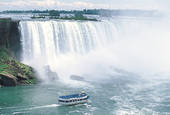
Lake Ontario is a lot similar to Lake Erie but is deeper and
has around four times the volume of water. Lake Ontario is located in
parts of New York and Ontario. Lake Ontario is known for its amazing and
unique waterfalls as shown in the picture to the left.
Moving on to our final feature we will go explore the depths of the forest.
There are 155 National Forests in North America. Of these forests we are going to take a look at Tongass National Forest. Tongass National Forest is the largest forest and is located in Sitka, Alaska. Its size is equivalent to the size of West Virginia at 25,913 square miles.
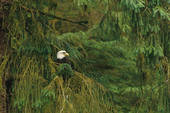
While exploring this national forest you will see eagles,
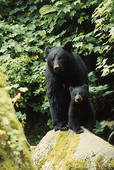
bears and spawning salmon.
While visiting this national forest make sure you hike the board walk trails, fish in the streams or ocean, rent cabins or even try sled-dogging on a glacier.
Getting back to the informational part of North America lets learn about the different climates. We find that North America has
every type of climate in it except tropical wet. This wide variation
of climate determines where people choose to live, work, grow crops
and where wild life lives.
- Tropical Humid Climatesare found in southern Florida, Arid and Semiarid along the Great Plains throughout the Western part of the US
- Temperate Climatesup along the West Coast in Canada and Alaska, and Southeastern part of the US
- Cool Humid Climatestake up the most part of Northern US, most of Canada and partially throughout the western part of the US
- Coldest Climates are found in the Northeastern peak of
Canada and Alaska (Pulsiper pg. 58 map)
Gender roles in North America are different than other regions of the world. The U.S. and Canada share many of the similar roles and they only differ in a few ways.
- Women have the right to vote on a national level and run for political positions (Gender 2011).
- Although men still hold all the top executive jobs, women in the US today can work and are not just perceived as homemakers.
- Women can go to school, go to college and get a degree, own land and houses and hold jobs (Gender 2011).
- Though they are employed, women in
North America only make 62 cents for every dollar a man makes. In
Canada, the women make more than the men (Pulsipher pg. 79).
Another subject discussed is the topic "Religion".
North America and Canada have a
wide arrange of religion due to the mix of cultures and personal
choice. Christianity is the dominant religion
in most households in North America (Pulsipher pg.89). Roman Catholic
dominates in regions where Hispanics, French, Irish and Italian.
Lutheranism is dominant in Scandinavian communities, Baptists are
dominant in the South and is an important part of their life.
Mormons and evangelical Christians are
the fastest growing. Americans do not believe in mixing
religion with state. They also do not mix them in schools, daily life
or conversation. (Pulsipher pg. 89).
Our final topic to cover on North America is cuisine. Due to the wide range of cultures in North America the variety of cuisine is large.
The cuisines in North America are of many. When you think of all the different staples we have access to throughout our region and from all of the minorities that have come to North America bring with them their own foods, restaurants, stores and deli's, we have the opportunity to sample everything.
From the fresh water fish, seafoods of the oceans, wild life in the woods and forests, cattle ranches, corn fields and much more crops to choose from. We have by far probably the widest variety to sample from.
The famous cheeseburger and French fries, pizza, spaghetti, Asian foods, Chinese cuisine, Tex-Mex, Mexican, seafoods, tofu, gyro's, steaks, roasts, vegetarian of course, poultry, bacon etc...the list goes on. Oh, last, but not least all of our chains of fast food restaurants.
The cuisines in North America are of many. When you think of all the different staples we have access to throughout our region and from all of the minorities that have come to North America bring with them their own foods, restaurants, stores and deli's, we have the opportunity to sample everything.
From the fresh water fish, seafoods of the oceans, wild life in the woods and forests, cattle ranches, corn fields and much more crops to choose from. We have by far probably the widest variety to sample from.
The famous cheeseburger and French fries, pizza, spaghetti, Asian foods, Chinese cuisine, Tex-Mex, Mexican, seafoods, tofu, gyro's, steaks, roasts, vegetarian of course, poultry, bacon etc...the list goes on. Oh, last, but not least all of our chains of fast food restaurants.
References:
123RF Stock Photos: Royalty Free Stock Photos. 123RF limited 2006-2010. Retrieved from http://www.123rf.com
10 of the Biggest, Largest Lakes in the World (2011). Hub Pages. Retrieved from http://hubpages.com
Fotosearch Stock Photography and Stock Footage: The World's Stock Photography-on Website. Great Basin Stock Photos and Images. Retrieved from http://www.fotosearch.com
The Great Basin. Exploring the Southwest Desert USA (1996-2011). Retrieved from http://www.desertusa.com
Gender Roles and Degrading Women in America (2011). Retrieved from http://www.associatedcontent.com
The Great Lakes. Last modified April 19, 2004. Retrieved from http://www.great-lakes.net
Pixmac Picture Market (2011). Travel to Hubbard Glacier in Alaska. Retrieved from http://www.pixmac.com
Pulsipher, L. M., and Pulsipher, A. (2008). World Regional Geography: Global Patterns, local lives (4th ed.). New York: W. H. Freeman and Company.
USDIA forest service. Tongass National Forest. Last modified February 03, 2011. Retrieved fromhttp://www.fs.fed.us
Wall Paper Dave's (2009). Rocky MountainNational Park Wall Paper Photographs. Last Modified December 20, 2009. Retrieved fromhttp://www.wallpaperdave.com
Wikipedia the free Encyclopedia. Last modified 6 February 2011. Retrieved fromhttp://www.Wikipedia.org
Worlds 7 Largest Glaciers by Continent. Last modified April 17, 2009. Retrieved from http://www.greenpacks.org
123RF Stock Photos: Royalty Free Stock Photos. 123RF limited 2006-2010. Retrieved from http://www.123rf.com
10 of the Biggest, Largest Lakes in the World (2011). Hub Pages. Retrieved from http://hubpages.com
Fotosearch Stock Photography and Stock Footage: The World's Stock Photography-on Website. Great Basin Stock Photos and Images. Retrieved from http://www.fotosearch.com
The Great Basin. Exploring the Southwest Desert USA (1996-2011). Retrieved from http://www.desertusa.com
Gender Roles and Degrading Women in America (2011). Retrieved from http://www.associatedcontent.com
The Great Lakes. Last modified April 19, 2004. Retrieved from http://www.great-lakes.net
Pixmac Picture Market (2011). Travel to Hubbard Glacier in Alaska. Retrieved from http://www.pixmac.com
Pulsipher, L. M., and Pulsipher, A. (2008). World Regional Geography: Global Patterns, local lives (4th ed.). New York: W. H. Freeman and Company.
USDIA forest service. Tongass National Forest. Last modified February 03, 2011. Retrieved fromhttp://www.fs.fed.us
Wall Paper Dave's (2009). Rocky MountainNational Park Wall Paper Photographs. Last Modified December 20, 2009. Retrieved fromhttp://www.wallpaperdave.com
Wikipedia the free Encyclopedia. Last modified 6 February 2011. Retrieved fromhttp://www.Wikipedia.org
Worlds 7 Largest Glaciers by Continent. Last modified April 17, 2009. Retrieved from http://www.greenpacks.org
